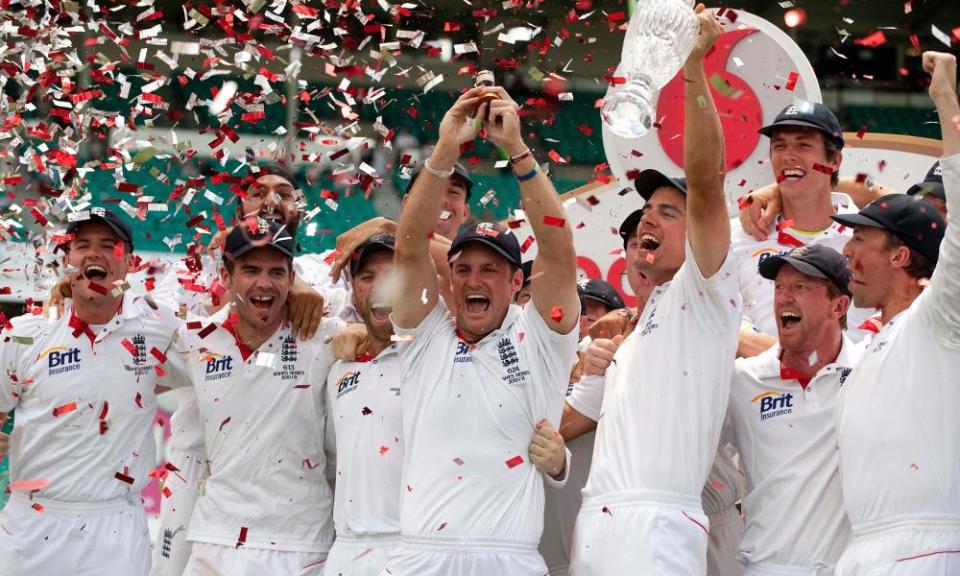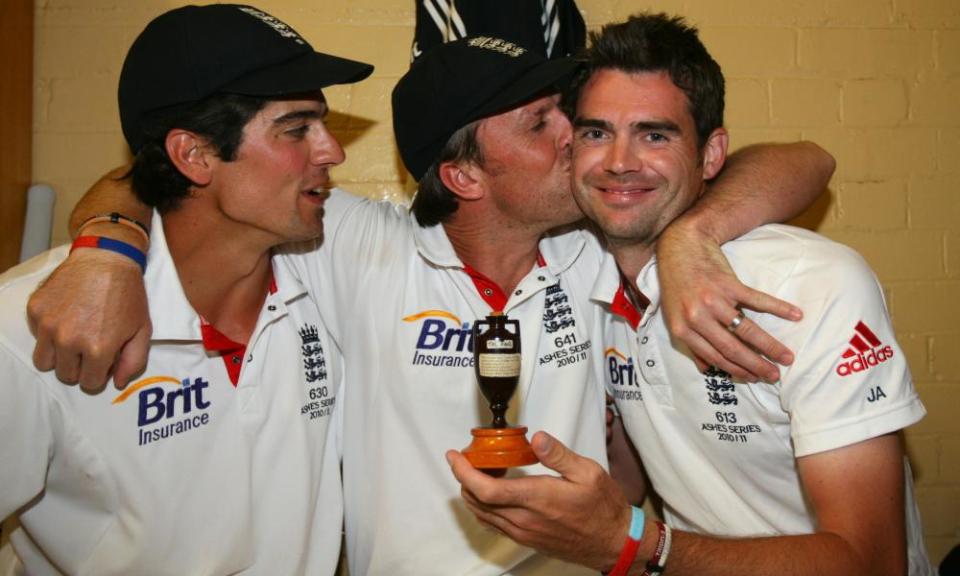2011 and all that: England’s last Ashes win in Australia still feels like a dream

England’s dominance on the 2010-11 tour came with two teams heading in different directions and is unlikely to be seen again
On Friday 7 January, 2011, Mike Skinner posted a short new video on YouTube; it showed him asleep on his sofa, an empty tea cup by his head, a crumpled carry pack of beer at his feet, while he read, in voice over, the opening paragraph of Mike Selvey’s Guardian match report from the last day of the Ashes. “They came in their thousands to form an English corner of a foreign field for the climax.” It is a sweet, pretty and strange thing, one last surreal little turn in a winter’s cricket so full of them that it felt something like one long dream. “Where am I?” Skinner asks at last as he opens his eyes.
Following the Ashes in Australia from back here in England always feels a little like that, bleary-eyed snatches of action watched on fluorescent TV screens while everyone else in the house is sleeping, or fragments of shouted radio commentary through an earpiece that startle you awake at two or three or four in the morning. Most of the time it all gets a bit nightmarish. The 2010-11 series was the exception. England have only won four Tests in Australia this century. Three of them were on that tour.
Related: Pat Cummins: the pace-bowling captain who could prove a pioneer | Ali Martin
It wasn’t just that they won. It was the way they did it. They played with a conviction, and ruthlessness, that felt entirely unfamiliar to anyone who had grown up following them on these tours. They became the first team in Ashes history to score four totals of 500-plus in one series, the first team in Ashes history to win three matches by an innings in one series; they broke – or threatened – records that had stood for well over a century. 517 for one at the Gabba, two for three at Adelaide, 98 all out in Melbourne, 644 at the Sydney Cricket Ground. Looking back on it now, 10 years later, it all feels even more fantastical.
At the time, people thought the win was going to be a watershed. “The Australian era of greatness has come to an end,” reported the Daily Mail, “while another takes hold, the era of English dominance.” England did reach world No 1, when they beat India at home the following summer. But the English aren’t good at being on top – they haven’t had enough practice. And things got very wobbly when they were beaten by Pakistan in the UAE the next winter, then fall apart altogether when they lost to South Africa in the summer of 2012. Back in Australia in 2013-14 they were battered 5-0, handicapped that time by their own administrators who had decided to flog them through back-to-back Ashes home and away.
The slump that came afterwards, and the failure to win even one of the 10 Tests they’ve played in Australia since, makes what happened in 2010-11 seem all the more unlikely.
There were lessons there in 2010-11, especially in the way England went about their cricket, which was patient but positive, marked by resilience, and real relish for the contest. They channelled their aggression into bowling dry and batting long, put the opposition through thankless days in the field, and then made sure they didn’t get any easy breaks when they were batting. Jimmy Anderson was trying to explain it on the BBC’s Project Ashes podcast this week. “You’ve got to be patient, but not defensive,” Anderson explained. “You’ve got to be aggressive in terms of the fields that you set and in terms of the lines that you bowl. You can’t just lob it outside off stump and try and bowl maidens – you’ve got to be challenging the bat all the time, and you’ve got to hit the pitch.”
But really, it’s difficult to use 2010-11 as a template. It owed too much to the unique circumstances of the time. It was the upshot of two teams passing each other at a very particular time and place in their development. Australia were still trying to work out how to fill the gaps left by all the great players – Matthew Hayden, Justin Langer, Adam Gilchrist, Glenn McGrath, Shane Warne – who had retired in the previous few years. They were so confused about what to do they ended up dropping their regular spinner, Nathan Hauritz, to replace him with another who had never played a Test, Xavier Doherty, then junking him for a third, Michael Beer, who had only played five first-class games.
England, on the other hand, were a settled side, with a crystal clear idea of their strengths, weaknesses, roles and the way they wanted to play. They had only lost two of the 12 Tests they had played in 12 months running up to the start, and nine of the 11 they picked for the first Ashes match in Brisbane had started every Test they had been available for in that time.

Andy Flower had been running the team for two years. Over time, Flower’s intensity would start to take its toll on the players, but at that point they were still buying into his way of doing things. He made the team go through a gruelling five-day military training camp in Bavaria the month before they flew out which, most of them cheerily admitted afterwards, they absolutely detested. Even Flower began to regret it. But it brought them together, if only because when it was all over they could laugh about how horrendous it was. They tried a similar thing all over again in 2013-14, and this time, the players ended up ridiculing it as a “farce”.
But in 2010, when they still had so much to prove, the players were willing to go along with the coaches. Not just Flower. Richard Halsall had drilled them into a crack fielding unit, and Graham Gooch hammered home the idea of scoring “daddy hundreds”. Then there was the fast bowling coach David Saker, who brought a little good humour, and a lot of local knowledge. Strauss had actually wanted to bat first on the morning they bowled Australia out at the MCG, until Saker took him to one side before the toss and told him: “Do that, and I will never talk to you again.” It wasn’t clear he was joking.
There was a real and very rare, sense that they all enjoyed each other’s company. Kevin Pietersen was still keen, lean and eager. He hadn’t yet fallen out with Strauss or grown sick of some of his teammates. Graeme Swann was in his pomp, the linchpin of a four-man attack led by Anderson, who had just come into his prime. Alastair Cook, who would have been dropped if he hadn’t hit a century in the last Test of the 2010 summer against Pakistan, was all of a sudden in the form of his life. Jonathan Trott, who hadn’t yet been ground down by the relentless pressure of international cricket, couldn’t put a foot wrong. Soon enough, all this would start to change. But 2010-11 was a happy trip, a high-water mark in English cricket. Did we dream it?

 Yahoo Sport
Yahoo Sport 



































































